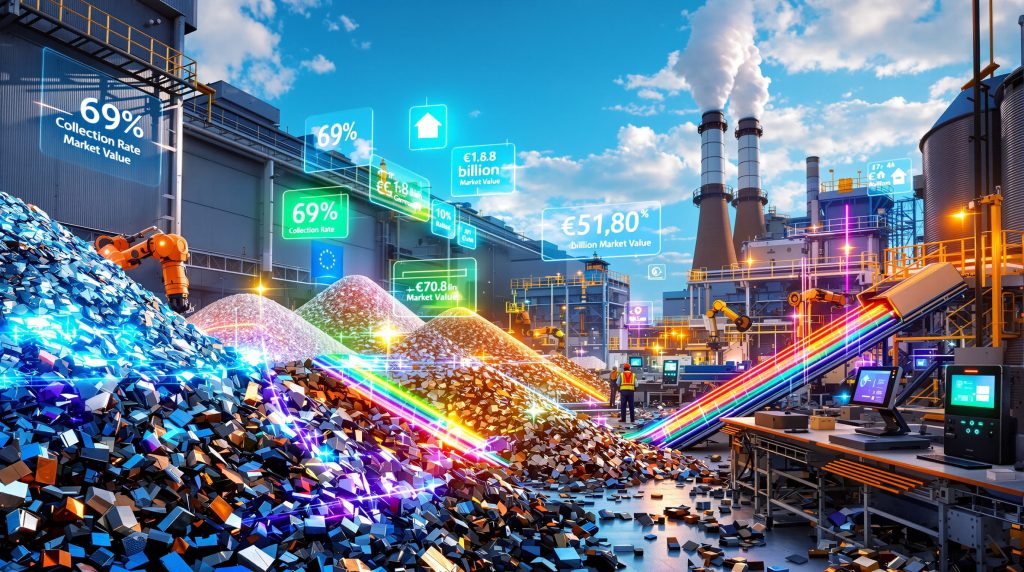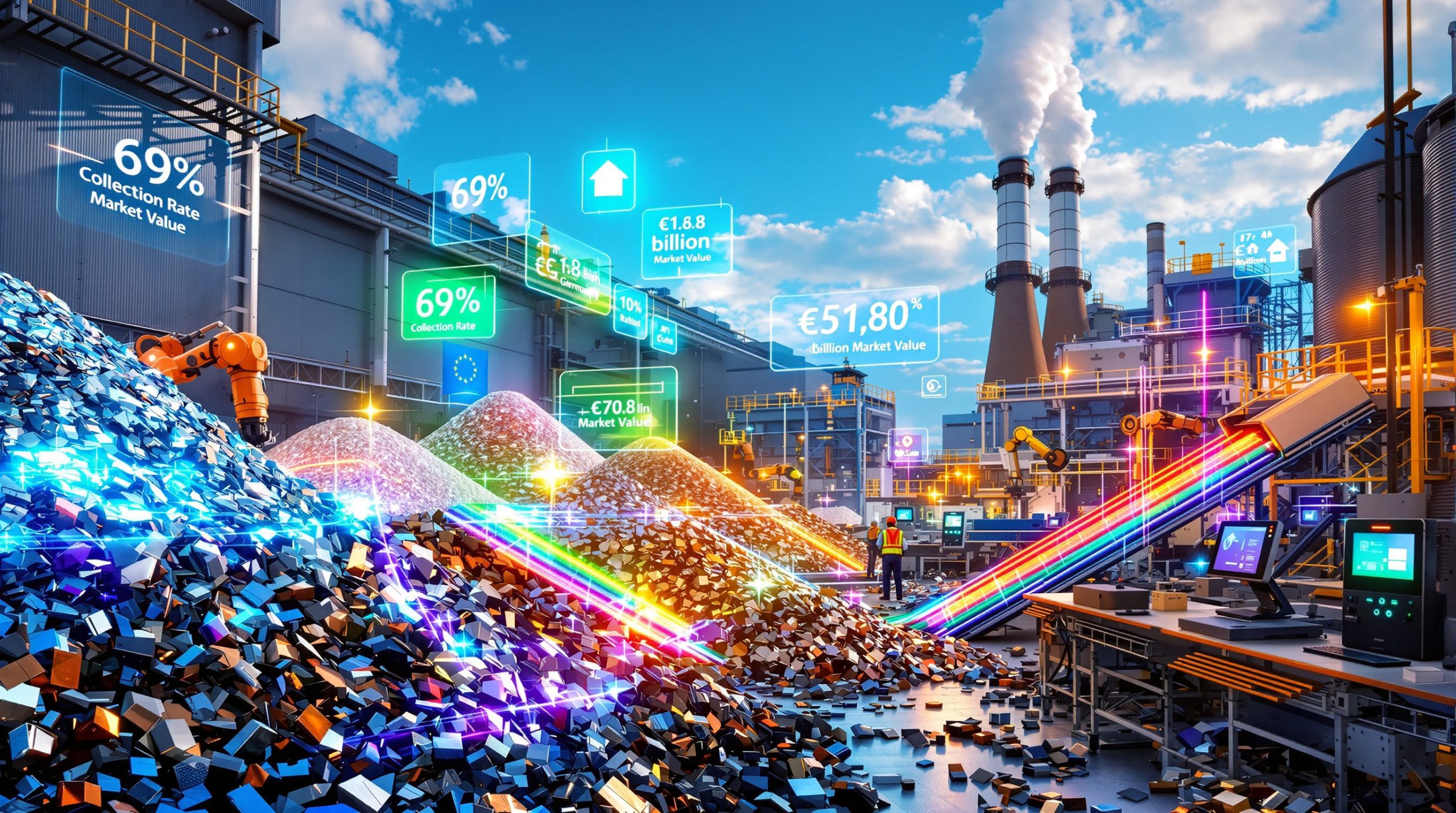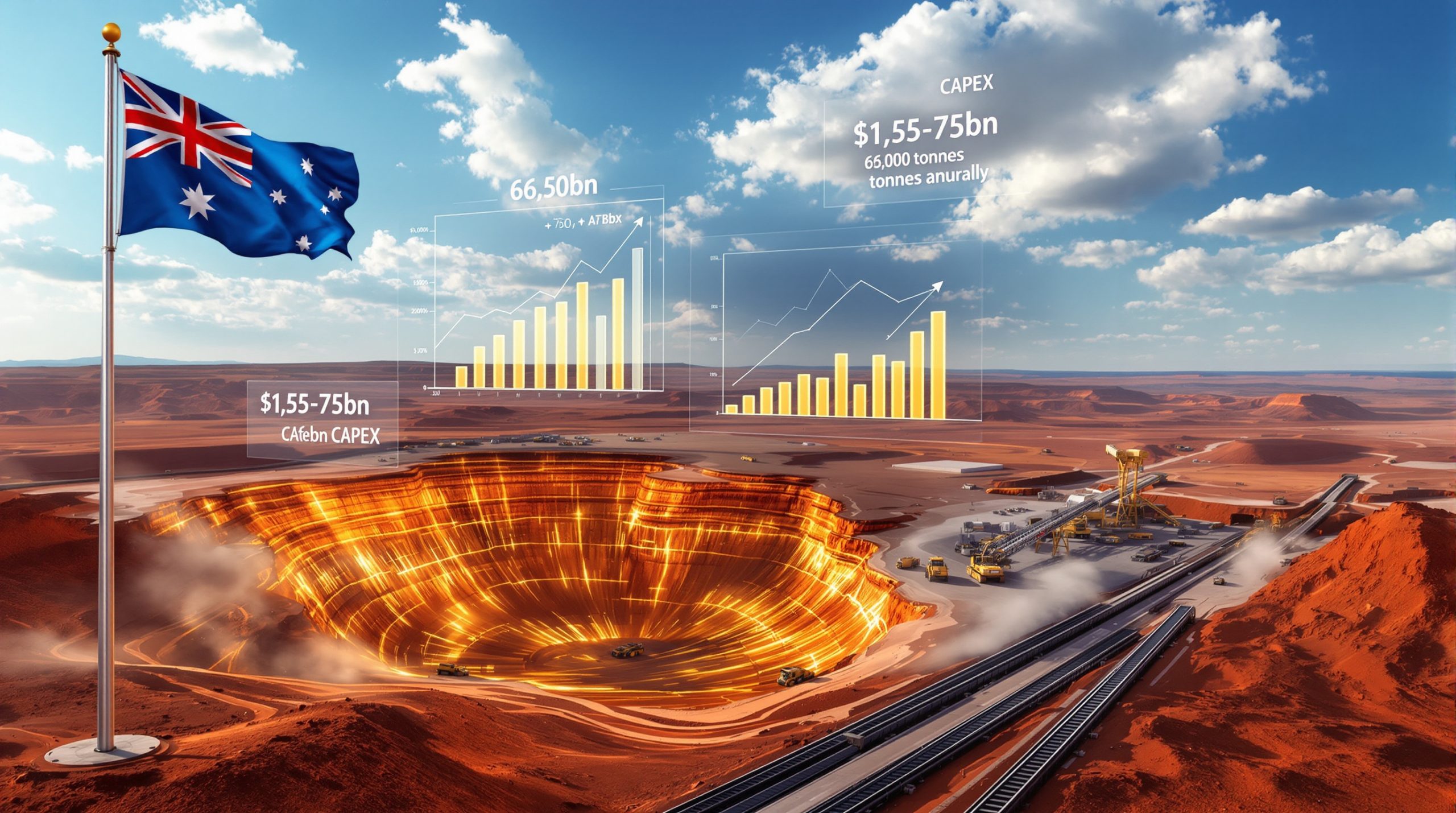European non-ferrous metal recycling in Europe has emerged as a critical component of this transition, demonstrating how advanced processing technologies and regulatory frameworks can create economic value while addressing resource scarcity challenges. The sustainability transformation within this sector reflects broader shifts toward circular economy principles that prioritise material recovery and reuse.
Advanced Infrastructure Systems Enable Circular Material Flows
The foundation of Europe's non-ferrous metal recycling success rests on sophisticated technological platforms that maximise material recovery while maintaining processing efficiency. Sensor-based sorting systems utilising X-ray fluorescence (XRF) technology can identify elemental composition with accuracy levels exceeding 99.5%, enabling precise separation of complex alloy mixtures. These systems operate at processing speeds of up to 10 tonnes per hour, significantly improving throughput compared to manual sorting methods.
Automated separation technologies incorporate multiple processing stages to optimise material purity. Magnetic separation systems remove ferrous contamination with efficiency rates approaching 99.8%, while eddy current separators achieve non-ferrous metal recovery rates of 95-97% from mixed waste streams. Dense media separation techniques enable the processing of complex automotive shredder residue, recovering valuable metals that would otherwise be lost to disposal.
Regional processing capacity distribution across Europe reflects both historical industrial development patterns and strategic policy initiatives. Germany maintains approximately 35-40% of total European non-ferrous processing capacity, leveraging established automotive and manufacturing infrastructure to support large-scale recycling operations. This concentration provides economies of scale while creating specialised expertise in complex alloy processing.
Eastern European markets demonstrate significant growth potential, with processing capacity expanding rapidly as manufacturers seek cost-effective secondary raw materials. Countries including Poland, Czech Republic, and Hungary have increased processing capabilities by over 25% since 2020, driven by automotive industry growth and EU circular economy directives.
Nordic specialisation focuses on high-purity precious metal recovery from electronic waste streams. Sweden and Finland have developed particular expertise in processing complex electronic components, achieving recovery rates exceeding 90% for precious metals including gold, silver, and palladium from WEEE streams.
Material Processing Volumes Reflect Market Demand Patterns
Aluminium represents the largest volume segment within European non-ferrous recycling operations, reflecting the metal's widespread application across packaging, automotive, and construction sectors. Collection rates consistently achieve 65-70% of total aluminium generated, representing approximately 2.8-3.0 million tonnes annually across EU member states.
| Aluminium Processing Metrics | Performance Data | Industry Impact |
|---|---|---|
| Collection Rate | 65-70% of generated volume | Supports circular packaging systems |
| Energy Efficiency | 95% reduction vs. primary production | Significant carbon footprint improvement |
| Processing Volume | 2.8-3.0 million tonnes annually | Major secondary raw material source |
| Quality Standards | 99.5% purity achievable | Enables closed-loop manufacturing |
The energy savings associated with aluminium recycling represent perhaps the most compelling economic driver for investment in processing infrastructure. Primary aluminium production requires approximately 13-15 kWh per kilogram, while recycled aluminium processing consumes only 0.5-0.7 kWh per kilogram. This 95% energy reduction translates directly to carbon footprint improvements and operational cost advantages.
Copper processing operations handle approximately 1.5-1.7 million tonnes of copper-containing materials annually, recovering high-purity copper for electrical and construction applications. The metal's exceptional electrical conductivity properties, measured at 56.5 × 10⁶ S/m, require minimal quality degradation during recycling processes, enabling multiple reuse cycles without performance loss.
Recovery efficiency for copper systems typically achieves 85-90% of contained metal content, with advanced hydrometallurgical processing enabling 99.9% purity for electrical applications. Value retention approaches 90-95% of primary metal pricing for premium-grade recycled copper, providing strong economic incentives for collection and processing investment.
Lead processing maintains particular significance due to automotive battery recycling requirements. Lead-acid battery recycling achieves recovery rates exceeding 99%, making this one of the most successful circular material systems globally. Processing volumes handle approximately 1.2-1.4 million tonnes of lead-containing materials annually, primarily from automotive and industrial battery sources.
Specialty metals processing includes zinc, nickel, and precious metals recovered from electronic waste and industrial applications. These materials command premium pricing due to specialised processing requirements and growing demand from renewable energy and electronics manufacturing sectors.
Processing Technologies Optimise Recovery Efficiency
Modern separation methodologies follow established metallurgical engineering principles while incorporating advanced automation and sensing technologies. Shredding and size reduction operations optimise particle size distribution for downstream processing, typically achieving 95-98% liberation efficiency for metal components.
Primary separation sequence includes:
- Magnetic separation: Removes ferrous contamination with 99.8% efficiency
- Eddy current systems: Achieves 95-97% non-ferrous metal recovery from mixed streams
- Density separation: Processes complex automotive shredder residue with 85-90% metal recovery
- Optical sorting: Enables alloy-specific separation with 99% accuracy rates
Advanced purification techniques address increasing quality requirements from manufacturing sectors. Pyrometallurgical processing utilises controlled atmosphere furnacing to achieve precise alloy compositions while managing contamination levels. Operating temperatures range from 600-1,200°C depending on metal type and desired purity specifications.
Hydrometallurgical methods provide alternative processing routes particularly suited to precious metal recovery and high-purity applications. Furthermore, these systems achieve 99.99% purity levels for specialised electronic applications while minimising energy consumption compared to traditional smelting processes. The battery recycling process demonstrates similar technological principles applied to lithium-ion battery materials.
Electrorefining techniques enable precision purification for copper and other conductive metals. Current density optimisation allows processing rates of 200-400 kg per square metre per day while maintaining electrical conductivity standards essential for manufacturing applications.
Vacuum distillation systems process volatile metal components including zinc and cadmium, achieving separation efficiency exceeding 98% for multi-metal recovery operations. These specialised techniques handle complex alloy mixtures that cannot be processed through conventional pyrometallurgical methods.
Regulatory Framework Drives Industry Development
European regulatory architecture creates structured incentives for non-ferrous metal recycling investment while establishing quality standards that enable secondary materials to substitute primary resources. The Waste Framework Directive (2008/98/EC) establishes mandatory waste hierarchy prioritising prevention, reuse, recycling, and recovery over disposal options.
Specific recycling targets under the directive include:
- 65% municipal waste recycling by 2035
- 55% construction/demolition waste recycling by 2030
- 70% packaging waste recycling by 2030 (including metal packaging)
End-of-Life Vehicles Directive (2000/53/EC) mandates 85% recovery rates by weight for vehicles, with 80% required for reuse and recycling specifically. These requirements create guaranteed demand for automotive metal recovery services while establishing quality standards for recycled materials.
The directive's impact extends beyond simple volume targets by requiring manufacturers to design vehicles for material recovery, creating upstream incentives for recyclability optimisation.
WEEE Directive (2012/19/EU) establishes escalating collection targets: 45% by 2016, 65% by 2019, and 85% by 2029. These requirements specifically address precious metal and specialty metal recovery from electronic waste streams, creating high-value processing opportunities.
Compliance mechanisms include:
- Material tracking systems providing chain of custody documentation
- ISO quality certification requirements for recycled material purity
- Environmental monitoring protocols for air and water quality
- Extended Producer Responsibility schemes making manufacturers liable for end-of-life management
Circular Economy Action Plan (2020) establishes climate neutrality by 2050 with 55% greenhouse gas emissions reduction by 2030. These targets create structural demand for secondary materials as manufacturers seek to reduce carbon footprints associated with primary resource consumption.
Economic Drivers Support Investment Growth
Market valuation trends reflect growing recognition of non-ferrous metal recycling as essential infrastructure rather than traditional waste management. In addition, industry evolution trends indicate consistent growth driven by regulatory requirements, resource security concerns, and manufacturing cost optimisation.
Energy cost advantages provide fundamental economic justification for recycling investment. Aluminium recycling requires only 5% of primary production energy, creating cost savings of €800-1,200 per tonne depending on electricity pricing. These savings compound as energy costs increase, making recycled materials increasingly competitive.
| Metal Type | Energy Savings | CO₂ Reduction | Cost Advantage |
|---|---|---|---|
| Aluminium | 95% vs. primary | 90% emissions reduction | €800-1,200/tonne |
| Copper | 85% vs. primary | 75% emissions reduction | €400-600/tonne |
| Lead | 60% vs. primary | 70% emissions reduction | €200-400/tonne |
Carbon footprint reduction creates additional economic value through emissions trading systems and corporate sustainability targets. Aluminium recycling avoids approximately 9-11 tonnes CO₂ equivalent per tonne of recycled material compared to primary production. At current carbon credit pricing of €80-100 per tonne CO₂, this represents €700-1,100 in avoided carbon costs per tonne of recycled aluminium.
Import substitution potential provides strategic economic benefits by reducing dependence on volatile commodity markets. European aluminium imports represent approximately 40% of consumption, creating vulnerability to supply disruptions and price volatility. Domestic recycling capacity could potentially substitute 15-20% of current imports, improving resource security while supporting local employment.
Resource security considerations become increasingly important as global competition for critical materials intensifies. Recycled materials provide supply chain resilience that cannot be achieved through import diversification alone, making recycling infrastructure a strategic economic asset.
Investment projections remain subject to commodity price volatility, regulatory changes, and technological developments that could significantly impact growth trajectories.
Collection Networks Integrate Multiple Supply Sources
Efficient material supply chains require integration of diverse collection sources ranging from municipal programmes to specialised industrial partnerships. Municipal collection systems handle approximately 35-40% of total non-ferrous scrap volumes, primarily from packaging and household electronic waste. These programmes benefit from comprehensive waste management solutions that optimise collection efficiency while maintaining material quality.
Multi-source integration includes:
- Residential collection programmes: Packaging, small appliances, and consumer electronics
- Commercial waste streams: Office equipment, industrial packaging, and construction materials
- Automotive dismantling networks: End-of-life vehicle processing and component recovery
- Industrial partnerships: Manufacturing scrap and process waste materials
Transportation optimisation requires specialised handling to prevent contamination and maintain material quality during transit. Dedicated transport equipment includes sealed containers for electronic waste, segregated compartments for different metal types, and contamination prevention systems.
Regional consolidation centres optimise logistics by aggregating materials from multiple collection points before transport to processing facilities. These facilities typically achieve 85-90% load optimisation while reducing transportation costs by 25-30% compared to direct collection routing.
Cross-border coordination within the EU enables optimisation of processing capacity utilisation. Standardised classification systems and harmonised quality standards facilitate efficient material flows between member states, allowing specialisation in particular metal types or processing techniques.
Digital tracking platforms provide real-time visibility into material flows and quality characteristics. Blockchain-based systems create immutable records of material provenance, supporting compliance requirements while enabling quality premiums for verified recycled content.
Quality Assurance Systems Enable Manufacturing Integration
Manufacturing sector integration requires recycled materials to meet or exceed performance standards established for primary materials. Purity specifications vary significantly across applications, with electronic-grade materials requiring 99.99% purity while construction applications may accept 98-99% purity levels.
Aluminium alloy specifications must match specific automotive, aerospace, and packaging requirements:
- 6000 series alloys: Automotive body panels requiring 99.5% minimum purity
- 5000 series alloys: Marine applications demanding corrosion resistance properties
- 2000 series alloys: Aerospace applications requiring precise strength-to-weight ratios
Copper conductivity standards require careful contamination control during processing:
- Electrical applications: Minimum 58 MS/m conductivity (equivalent to 101% IACS)
- Telecommunications: 99.9% minimum purity for signal transmission quality
- Plumbing applications: 99.8% purity with controlled lead content
Testing and certification protocols include:
- Chemical composition analysis using X-ray fluorescence and atomic absorption spectroscopy
- Physical property testing for mechanical strength, conductivity, and corrosion resistance
- Contamination assessment identifying and quantifying foreign material content
- Traceability documentation providing material origin and processing history
ISO certification requirements include ISO 11175 for aluminium, ISO 1571 for copper, and ISO 12944 for protective coatings. These standards enable recycled materials to command pricing equivalent to 95-100% of primary material values for premium grades.
Technology Innovation Enhances Operational Performance
AI-powered efficiency systems optimise sorting accuracy and processing efficiency through machine learning algorithms that adapt to changing waste stream compositions. Artificial intelligence integration achieves identification accuracy exceeding 99.5% while reducing labour requirements by 40-50%.
Robotic processing systems handle complex separation tasks including wire stripping, component disassembly, and contamination removal. Advanced robotics increase processing throughput by 25-30% while improving worker safety in hazardous material handling operations.
Predictive maintenance programmes utilise IoT sensor networks to monitor equipment condition and optimise maintenance scheduling. These systems reduce unplanned downtime by 35-40% while extending equipment life by 15-20% through optimised maintenance intervals.
Supply chain analytics provide demand forecasting and inventory optimisation capabilities. Machine learning models analyse historical data, commodity pricing trends, and manufacturing schedules to optimise collection and processing timing, improving margins by 8-12%.
Emerging technology applications include:
- Blockchain tracking systems: Immutable material provenance records supporting premium pricing
- Advanced sensor networks: Real-time process monitoring and quality control
- Novel extraction methods: Biotechnology and electrochemical processing for specialty metals
- Energy recovery systems: Waste heat utilisation improving overall process efficiency
Digital twin technology enables process optimisation through virtual modelling of complex sorting and processing operations. These systems reduce commissioning time for new equipment by 30-40% while optimising operational parameters for maximum recovery efficiency.
European Leadership in Global Markets
European non-ferrous metal recycling demonstrates technological and regulatory advantages that position the region as a global leader in circular material systems. Advanced processing capabilities enable Europe to process complex waste streams that many other regions export for disposal, creating economic value while addressing environmental challenges.
Regulatory maturity provides competitive advantages through:
- Comprehensive policy frameworks creating predictable business environment
- Quality standards harmonisation enabling cross-border material flows
- Extended Producer Responsibility systems internalising end-of-life costs
- Circular economy integration linking recycling to broader sustainability objectives
Technological sophistication enables processing of increasingly complex material streams including:
- Electronic waste containing multiple precious and specialty metals
- Automotive components with sophisticated alloy compositions
- Renewable energy infrastructure requiring specialised material recovery
- Advanced manufacturing waste from high-tech industries
International trade dynamics position Europe as both a processing centre for global materials and an exporter of high-quality recycled materials. European facilities process approximately 15-20% of globally traded non-ferrous scrap while exporting €2.5-3.0 billion in recycled materials annually.
Technology transfer opportunities enable European companies to export expertise to emerging markets while creating new revenue streams. However, the European non-ferrous metals industry continues to lead innovation in sustainable processing technologies. Consulting and equipment export services represent growing market segments as other regions develop recycling infrastructure.
Standards harmonisation efforts led by European organisations influence global best practices, creating advantages for European companies in international markets while promoting sustainable practices globally.
Future Transformation Drivers
Electric vehicle proliferation creates new material recovery opportunities while challenging existing processing infrastructure. Lithium-ion battery recycling requires specialised techniques for recovering lithium, cobalt, nickel, and rare earth elements not currently processed in large volumes.
Battery material recovery targets include:
- Lithium: 90% recovery from lithium-ion batteries by 2030
- Cobalt: 95% recovery supporting ethical sourcing initiatives
- Nickel: 85% recovery reducing primary mining dependence
- Rare earth elements: 80% recovery from permanent magnets
Renewable energy infrastructure growth generates new waste streams requiring specialised processing capabilities. Wind turbine recycling must address composite materials and permanent magnets, while solar panel processing requires recovery of silver, silicon, and specialty materials.
Urban mining expansion represents significant growth potential as building renovation and infrastructure replacement accelerate. Building-integrated materials including copper wiring, aluminium framing, and specialty alloys create accessible material sources in urban areas.
Circular design integration requires closer collaboration between recyclers and manufacturers to optimise material flows. Design for recyclability initiatives create products with improved material recovery potential while reducing processing complexity.
Strategic challenges requiring attention include:
- Material complexity increases as products incorporate more sophisticated alloys and composites
- Quality requirement escalation for high-tech manufacturing applications
- Economic volatility from commodity price fluctuations and supply chain disruptions
- Regulatory evolution as environmental standards become more stringent
Investment priorities focus on advanced sorting technologies, specialised processing capabilities for emerging waste streams, and digital integration systems supporting supply chain optimisation. Consequently, these developments will determine Europe's continued leadership in global non-ferrous metal recycling markets while supporting broader circular economy objectives. Furthermore, the comprehensive approach to metals recycling in Europe demonstrates the sector's commitment to sustainable resource management.
Forecasts regarding future market developments involve significant uncertainty and should be evaluated considering multiple scenarios including technological, regulatory, and economic variables that may affect actual outcomes.
Looking to Capitalise on Australia's Next Mining Discovery?
Discovery Alert's proprietary Discovery IQ model delivers real-time notifications on significant ASX mineral discoveries, instantly empowering subscribers to identify actionable opportunities ahead of the broader market. Understand why major mineral discoveries can lead to substantial market returns by exploring Discovery Alert's dedicated discoveries page, showcasing historic examples of exceptional outcomes, and begin your 30-day free trial today to position yourself ahead of the market.




